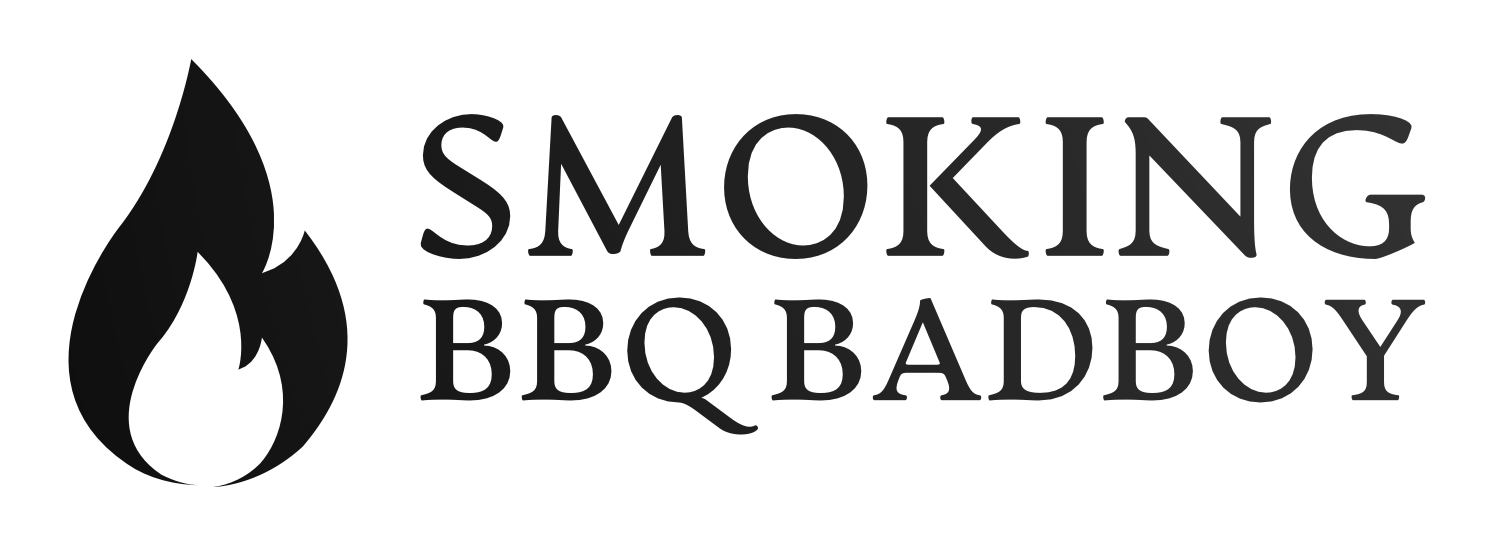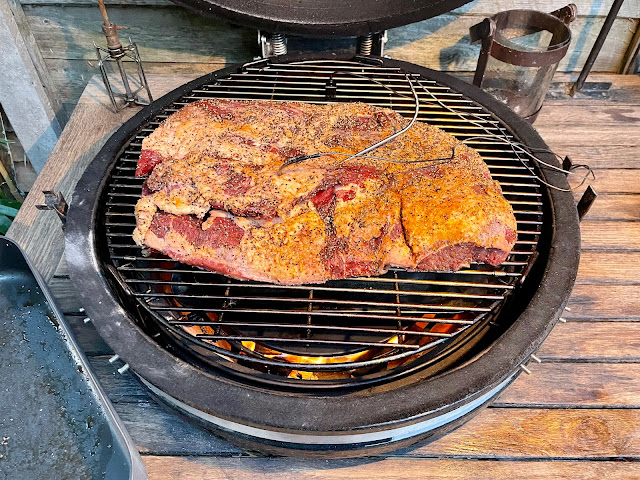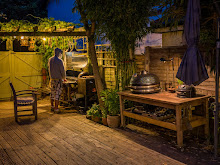How to make the best BBQ brisket in UK
A BBQ addict's experience of how to make the best BBQ brisket beef in UK
Our amazing weather in UK in 2023 has allowed extensive experiments with various techniques to BBQ the best possible beef brisket and beef short ribs in the offset smoker, the ceramic egg BBQ and both in combination. Aaron Franklin has been a fantastic inspiration both with his books & online tutorials, in terms of getting deeply technical about the various stages involved in cooking the best possible BBQ brisket.
It can be information overload, with so many different methods of approach to the main stage of the BBQ brisket cook (wrapped/unwrapped, boated/spritzed, 225f/250f/275f), though thankfully for my sanity, there also appear to be several universal 'truths' (good blue smoke, probe like butter, 203f to pull, rest for 1hr+).
This page is a distillation of my research and experience to help get you cooking the best possible BBQ brisket you can, as quickly as you can. There are more details BBQ brisket how to videos & tutorials out there, and if you have the time, I do recommend you go down the rabbit hole to consume as much information as possible. But my experience of working with BBQ brisket here in the UK has shown me that it is sensible to draw a line between that of those who make this classic American BBQ dish - the BBQ beef brisket - in American vs what it is like to BBQ a brisket in the UK.
20hr BBQ brisket cook in the offset smoker at 2am in my outdoor kitchen
Rather than create a video or a 'final' page regarding "how to BBQ beef brisket", I will update this page on a continual basis (UPDATED: June 17th, 2023) as I learn more to share in a one location, helpfully without overloading the ready, my experience of how to cook the best BBQ beef brisket on offset smokers & ceramic egg BBQs in the UK.
Why focus on the best BBQ beef brisket when there are so many BBQ options?
From what I've learnt, BBQed beef brisket is the highest level of BBQ cookery (in terms of a single cut of meat - some would argue the 'whole hog' is the most technically challenging due to the variety of cuts to be dealt with in one cook) due to the taste & texture profile potential for the final product. It took a little while for me to come onboard with this, because I am not the biggest fan of beef - especially roast beef, so the potentially for BBQ beef brisket as a final destination for consumption had to be immense.
I am a student again each time I cook a BBQ beef brisket, even with hundreds of BBQs under my belt. A real 'pitmaster' seems able to guarantee a consistent end result by feel during a cook but I still find myself thinking "why is this piece of brisket stalling for so long" or "why is this probing so tough on the edge whilst the middle is so tender"? Maybe over time I will be able to "just know", as someone like Aaron Franklin seems to instinctively but I doubt I will get through as many briskets as he has done, so it's not likely.
So whilst every piece of beef brisket is unique, following it's own path towards reaching a final product of beautifully smoke-seasoned, deliciously tender & dripping with moisture perfection, getting to the end result consistently is a challenge. Especially when you can track & see things happening differently in the cooking process using tools like temperature graphs on wifi based thermometers.
My offset smoker (nicknamed "The Beast") starting on a 7kg UK grass fed brisket
The general consensus indicates that I need to make a trip to visit Aaron Franklin's restaurant in Austin, Texas, USA to establish a baseline for true excellence - but being based here in the UK, it's a bit of a journey. And being based in the UK, there are some challenges to cooking the best possible BBQ beef brisket that are unique to the UK:
- Climate - our ambient temperature is generally lower than the best places to cook brisket in the USA, so more effort it required to keep offset smokers at a consistent temperature
- Product - the beef brisket available in the UK is generally grass fed, which results in less intramuscular fat to keep the brisket moist during the BBQing process
- Fuel - whilst England has the most oak trees in Europe, the wetter weather means that finding properly seasoned oak wood - and keeping it sufficiently dry without kiln drying is difficult
Three challenges to making the best BBQ beef brisket when in the UK
CLIMATE as a challenge when cooking BBQ brisket
For people who have not lived and BBQed in the UK, you might think that the most difficult thing we contend with is rain. Not quite. In the evenings, it usually gets chilly (around 8 to 11c degrees or 46 to 52f) even in the summer months. These nighttime temperatures can absorb warmth from an offset smoker, to the point where I would often consider doing the overnight element of even an offset smoker cook in the ceramic BBQ to ensure consistent temperatures.
Working some BBQ beef brisket and short ribs on a UK night BBQ
This might compromise of 4 hrs at 275f in the offset smoker using oak wood logs to apply depth of flavour to the BBQ brisket between 8pm and 12am before the temperature starts to drop too rapidly (around 12am). Whilst the BBQ brisket is getting it's final hour of good smoke in the offset, I will start to prepare the ceramic egg BBQ, which is capable of running for 12 hrs on a single load of charcoal.
Using charcoal means I am 'not cheating' by finishing the brisket off in the electric oven which after testing, revealed significant fluctuations in the temperature as it tries to maintain an even temperature.
Left graph is electric oven / right graph is ceramic Kamado egg BBQ (circled is where I 'set' the temp lower using the app).
If my target was 245f, an electric oven can range between 215f and 265f in the space of three minutes, it turns out. That is a huge variation when compared to consistent temperatures achieved of between 232f and 237f achieved when I set the temperature to 235f on a ceramic offset smoker using a temperature controlled fan system.
Putting into the brisket into the ceramic egg BBQ provides three key benefits to the second stage of a cook in this case:
- Continued BBQing by smoke (even if it's is charcoal smoke which does not have the same complex, deep flavour profile as as oak splits)
- More stable BBQing temperature through the whole process of cooking the BBQ brisket, especially when the ceramic lid provides better insulation against evening temperatures in the UK
- A good night sleep without the need for fire management as required by an offset smoker
PRODUCT as a challenge when cooking BBQ brisket
In the UK, we generally do not have access to the quality of beef brisket that is available in the USA. This doesn't mean that the beef is of a poorer quality but rather that it is less suitable to slow and low BBQing style of cooking because of how cattle is reared in the UK. Beef in the USA is generally grain fed, which builds more marbling of fat within the meat itself.
Most cattle in the UK is grass-fed and free-roaming, which results in a much leaner brisket with less intramuscular fat and connective tissues which are essential in producing the best possible BBQ brisket. I am not saying it's impossible to create great brisket but when working with beef freely available here, there some modifications to the BBQing process that can be introduced, as well as considerations when sourcing your brisket for a BBQ.
Sourcing
If you can, go to a 'whole carcass' butchers or farm shop.
Hallal butchers are more often whole carcass than traditional high street butchers who often receive their briskets pre-butchered / vac-packed. Whilst there is a benefit of longer shelf life available in vac-packed brisket, when factory butchered, much of the 'good stuff' in terms of fat cap is trimmed away before the butcher receives the brisket. This can't be put back on - and a caramel, sticky, candied fat cap on a brisket is worth it's weight in gold in terms of adding flavour to a BBQ brisket.
So, when going into a butchers or farm shop, try to work with the butcher to get your ideal cut of brisket directly from the carcass without the butcher 'trimming out' the 'excess' fat. You can do that yourself when the brisket is back at home but keeping a decent fat cap layer will protect your beef brisket during the BBQ.
FUEL as a challenge when cooking BBQ brisket
Finding & keeping good quality, dry oak wood is difficult in place that rains as much as it does in the UK. A moisture meter is going to help identify rouge pieces of wood that might be too wet to BBQ with but for the cleanest possible smoke, you should be aiming for a moisture content between 5% and 15%.
5% might sounds too dry but those oak logs will absorb moisture of the air here in the UK fast enough and if you are going beyond 20%, you might need to wait months before the logs are dry enough to throw into your fire chamber without smoking up before they catch aflame.
If you are able, keeping the logs on top of the wood chamber or even pre-heating inside the fire chamber next to the burning fire can help ensure you have the best possible blue smoke rather than dirty smoke.
The best BBQ brisket possible in the UK after you've addressed the challenges - the BBQ cook itself!
Discussing 'the cook' could take just as long as discussing the specific challenges we face when making BBQ brisket in the UK. However, the bullet point overview is:
- Source the best possible brisket you can with good intramuscular fat & connective tissues - these are the good bits which will render down, convert into gelatine when the brisket is cooking at temperature of 165-180.
- Season the brisket well using standard SPG (salt, pepper & garlic) and leave the SPG to penetrate the meat for a few hours at least or overnight, if you can.
- Prepare your fuel for offset smoker AND ceramic egg BBQ - check moisture levels & identify the best logs on any given day. You are always aiming for the cleanest possible smoke and this is as much an outcome of the fuel you use, as it is you fire management process.
- Start the offset smoker aiming for 225 to 275f depending on the size of smoker you have. Smaller offset smoker move less air and 'sit' on the meat for longer, transferring more heat, so the larger the smoker, the higher the temperature you can use for effectively the same cooking times.
- The first stage of the cook (up to around 160f & around 4hrs), in the offset smoker, is primarily about flavour profile generation using good, clean smoke. Oak logs are preferred to charcoal and an offset smoker preferred to a ceramic egg BBQ. This can last around 2 to 6 hrs, with average being around 4 hrs, till the BBQ brisket starts to go into a stall (at around 160f).
- Spritzing - during the first stage, about half way through, spritzing the brisket can help keep the edges from drying out and increase smoke penetration. However, I don't think that spritzing to 100% required and prefer a mop approach which helps to add more flavour and tenderize the meat more than a spritz would do.
- The second stage of the cook (up to 203f and around 8 hrs, which I do in the ceramic egg BBQ). can generally be considered the 'wrapped' stage (even if I don't necessarily wrap my brisket). If you have access to a ceramic BBQ:
- leave the brisket 'open', so it continues to take on smoke profile from the charcoal, in a method more akin to Franklin's BBQing process which is 100% in an offset smoker (even if wrapped)
- place in 'open foil boat', which will allow the brisket to confit in tallow and still take on flavour from the charcoal
- wrap in butcher paper to contain the steam & tallow, helping to reduce the overall BBQing time for the brisket
- The second stage cook is complete when the internal temperature of the brisket reaches 203f (the easiest and most common way to measure 'doneness') or when the brisket has the right feel in terms of:
- Floppiness - the brisket should feel floppy and almost jello-like when held from underneath and 'jiggled'. A 'jiggley' feel to a brisket is another indication of completeness but these 'feel' methods tend to come from experience.
- Softness - using a temperature probe, there should be no tightness when inserting the probe and pulling out from the BBQ brisket at all points. If the brisket is wrapped, the butcher paper can create artificial resistance, particularly when inserting the probe.
- Resting. Let your BBQ brisket rest for sufficient time - which can be 1hr or 3hrs or even longer. All depends on where you rest the brisket - on a counter top, in a heat insulated box, etc.
I realise that other people like Aaron Franklin, Mad Scientist BBQ and the professionals from American BBQ Showdown will go into a lot more detail in each one of the steps above but with so many experts covering the process itself for creating the best BBQ brisket in ideal conditions, more of the detail on addressing the challenges for cooking a BBQ brisket in the UK was more important for me to document.
The detail of the cook:
Spritzing
Spritzing the BBQ brisket involves spraying or misting the meat with a liquid during the BBQing process. I keep a water spray bottle always hanging underneath the offset smoker, filled with water, so it's super easy not to miss out on spritzing (though, as discussed later, mopping is another option)Mopping
The stall
The "stall" is something that occurs most of the time when barbecuing beef brisket. The internal temperature of the brisket levels off and can even decrease in spite of the temperature inside the smoker remaining at your target cook temperature.This can be confusing and even concerning, especially when internal temperatures show significant drops (as it I've had in stalls where the brisket has dropped as much as 10F in the internal BBQ brisket temperature).I think of this process as the 'jellification' of the brisket - where the connective tissue starts to break down to gelatine, which is then able to absorb and hold moisture, when it repatriates the meat - creating succulent BBQ beef brisket with 'jiggle'. Maintaining a consistent temperature in the smoker or ceramic egg BBQ (as I prefer to use at this stage) is important to keep the process going because variations in temperature, especially if it drops below connective tissue isn't being converted into gelatin (around 160-170°F (71-77°C)).
Techniques to help deal with 'the stall'
Foil boat method / 'Texas crutch'
Butcher's paper wrap
 Reviewed by smokingbbqbadboy
on
June 17, 2023
Rating:
Reviewed by smokingbbqbadboy
on
June 17, 2023
Rating:



















No comments:
Food, recipe or travel comments only please!